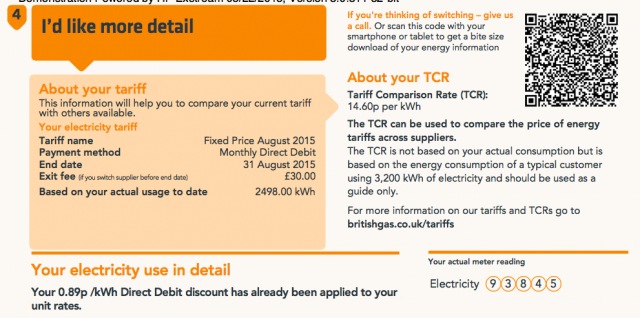
Do you have a QR code on your energy bill like the one pictured above? You are not alone – everyone has one on their energy bill! You have the Government to thank for that one, who presume you’re going to need it. But what are QR codes, and why are they on your bill? In this article, you’ll find out!
What is a QR code?
QR is an abbreviation for ‘Quick Response’. And so the full name for the QR code is ‘Quick Response code’. A QR code is similar to a barcode, in that it holds information, and you access this information by scanning the code with a compatible reader.
Related: What are smart meters?
In the case of QR codes, smartphones, tablets or indeed any device with a camera and a dedicated QR code application are that reader.
Why is there a QR code on my energy bill?
If you have found a QR code on your energy bill, scanning it with your smartphone will probably take you to your online account, where you can view an itemised e-bill.
The British Government made it a requirement for all future energy bills to contain a QR code under the Energy Act. The decision was announced by former Secretary of State for Energy and Climate Change, Edward Davey. The Government made the inclusion of QR codes mandatory on energy bills, with the hope that it would simplify energy for consumers.
Related: British Gas Hive Active Heating thermostat guide
How can I scan and read QR codes?
All you have to do to access the information that a QR code holds is this: Download a QR reader app onto your smartphone, tablet or any other device with a camera and a web browser and use your camera as the trigger. Here’s are some free apps to get you started:
– QR Droid Code Scanner (Google Play, Android devices)
– QR Code Reader (Google Play, Android devices)
– Quick Scan QR Code Reader (iTunes, Apple devices)
– QR Code Reader by Scan (iTunes, Apple devices)
– QR Code Reader (Windows Phone 8, Nokia Lumia)
Also if you have a Windows Phone, you can use a feature called Vision Search which uses your phone’s camera to scan what you see and then search for those things on the web.
Why is there a QR code on my energy bill?
The British Government made it a requirement for all future energy bills to contain a QR code under the Energy Act. The decision was announced by former Secretary of State for Energy and Climate Change, Edward Davey. The Government made the inclusion of QR codes mandatory on energy bills, with the hope that it would simplify energy for consumers.
Related: British Gas Hive Active Heating thermostat guide
Where will the QR code on my energy bill lead?
That’s a great question. The vast majority of QR codes on energy bills lead to a log in page, where upon entering your details you will be presented with an e-bill; this is usually a direct copy of the paper bill you already have, so it’s hardly helpful.
Other times, QR codes on energy bills might take you to a page showing your energy consumption and costs to date, with tips on how to be greener. It’s important to consider that all QR codes on energy bills should be helpful. If yours is not helpful, then tell your energy supplier as soon as possible so that they can look into it.
But wait, aren’t QR codes dead?
QR codes have been called a lot of things, one of our favourites being the blinking VCR clock of the 21st century. Which is to say, not many people are really using them.
However, they aren’t dead, and they probably never will be, at least not until something better comes along that can bridge the gap between paper and the internet.
The biggest challenge QR codes face is actually the people trying to use them. A lot of people simply don’t know how to use them, and refuse to use them after their first failed attempt. But thankfully, with the apps and guidance we’ve provided above, now you do.




